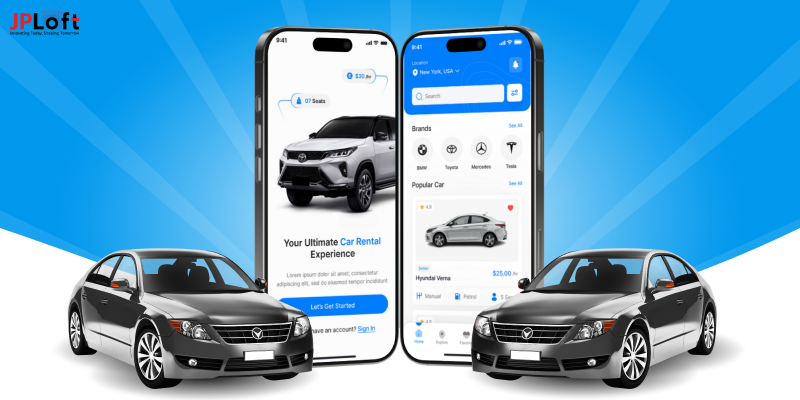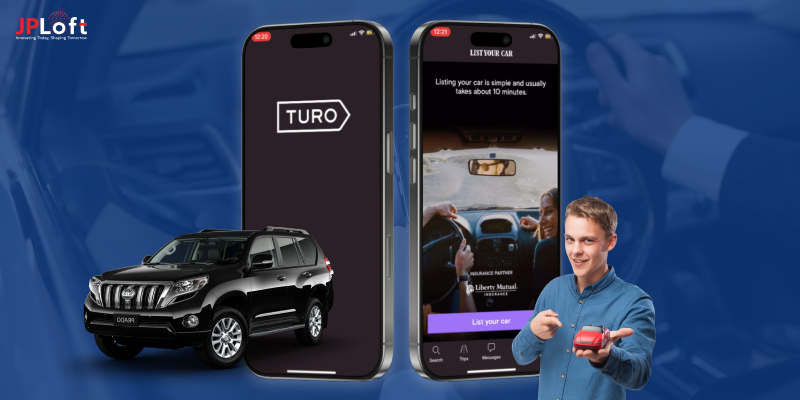Car rental apps have become a lifeline for travelers and locals alike. With just a few taps, users can easily access a wide range of vehicles for any occasion like a weekend getaway, a business trip, or just a quick ride.
However, while these apps have revolutionized the way we rent cars, behind the scenes, the road to success is far from smooth. From managing real-time availability to ensuring seamless customer experiences, car rental apps face a myriad of challenges that can make or break their performance.
In this blog, we’ll dive into the top challenges of car rental apps that developers and service providers face in the ever-evolving world of car rental technology. Let's understand it in detail.
What is a Car Rental App?
A car rental app is a kind of digital platform aimed at making the life of any user much easier when renting a vehicle through a smartphone or tablet.
In particular, it connects customers with rental service providers, allowing booking and payment of the vehicle quickly, as well as vehicle tracking, all in a few clicks.
Such apps ease the process of ordering a car for daily commutes, road trips, or business travel through real-time vehicle availability, detailed pricing negotiation, and secure web transaction features.
Some of the challenges that you should think about when you want to create an app for car rental are important hurdles besetting such an undertaking. So, let's discuss why investment in the car rental app can be a game-changer for your business.
Why Should You Develop a Car Rental App?
If you’re planning to start a car rental business, having a mobile app is no longer just an option, it’s a necessity. People now prefer the ease of booking a car with a few taps on their smartphones rather than dealing with long paperwork or phone calls.
A well-designed car rental app can streamline your operations, attract more customers, and give you a competitive edge. Here’s a detailed breakdown of why investing in a car rental app is a smart move that you should know before developing a car rental app:
-
-
Customers can book a car anytime, anywhere, without waiting for office hours or visiting a rental location. An app ensures instant reservations and cancellations, making the process hassle-free.Managing vehicle availability, tracking rentals, and scheduling maintenance becomes effortless with an app. You get a real-time overview of your fleet, reducing delays and operational inefficiencies.
-
According to Statista, the car rental market in the United States is expected to grow annually at a rate of 4.03% between 2025 and 2029. It can result in a market volume of $38.29bn by 2029.
-
An app helps you tap into a wider audience by offering online bookings, promo deals, and membership benefits. More accessibility means more bookings and higher profits.
-
If you’re ready to create a car rental app, the next step is understanding the challenges and how to overcome them for a seamless experience. Let’s dive into the major development challenges of car rental apps.
Major Challenges of Car Rental App Development
Developing a car rental app looks like a simple process: users book a car, pay for it, and drive it. But there are quite a few complexities trapped in the car rental app development process. Also, managing a fleet appropriately, ensuring a top-notch UI with several common development challenges for a car rental app.
So let's break down the biggest development challenges in car rental apps, along with their solution methods.
1. Fleet Management & Vehicle Availability
Fleet management is one of the main development challenges of a car rental app. The demand for vehicles is often fluctuating, thus making it ever a tough task to ensure it's available for users when needed the most.
Problems like overbooking, maintenance schedules, and wrong distribution of vehicles all over locations can exacerbate the situation a great deal. There could also be mechanical failures or last-minute cancellations, which might disturb the operations completely and lead to disgruntled customers.
This type of feature can increase the cost to create a car rental app, but the absence of an efficient fleet management system would greatly present these challenges of car rental apps when trying to meet demand and supply.
How to Overcome It?
-
- Real-Time Vehicle Tracking: Implement a GPS-enabled system to monitor each vehicle’s status, ensuring availability and easy management.
- Automated Fleet Scheduling: Use AI-powered tools to predict demand, optimize fleet distribution, and avoid shortages or overbooking.
- Regular Maintenance Alerts: Integrate automated reminders for servicing and maintenance to prevent breakdowns and customer dissatisfaction.
- Multi-Location Management: If operating in multiple cities, ensure that cars are evenly distributed to meet user demand effectively.
2. Real-Time Booking & Scheduling Issues
Handling real-time bookings is one of the biggest challenges while developing a car rental app. This may include aspects such as issues of double booking, last-minute cancellations, and lack of real-time confirmation.
Without a dedicated system, rental companies find it difficult to work in iterations between bookings, their availability, and fleet management, thereby causing customer dissatisfaction, lost revenue opportunities, and general operational inefficiencies.
There is a need for an integrated booking system so that customers can confidently reserve vehicles while rental companies manage their fleets without disruption.
Partnering with an experienced mobile app development company, you can ensure the smooth process of real-time booking and scheduling.
How to Overcome It?
-
- Automated Booking System: A smart algorithm should update vehicle availability in real-time to prevent double bookings.
- Cancellation & Refund Policy: Offer a flexible yet fair cancellation policy with instant refunds to maintain trust.
- AI-Powered Demand Prediction: Use data analytics to forecast peak booking times and allocate resources accordingly.
- Instant Notifications: Send real-time alerts to update users on booking status, pickup locations, and changes.
3. Pricing & Dynamic Fare Adjustments
The other part of the puzzle is ultimately deciding exactly what price to set. A dynamic pricing approach generally adds a lot of challenges to car rental apps. The issues facing car rental apps globally include the fact that the pricing is set based on demand, location, type of vehicle, or outer competition.
If the price is too high, users abandon the rental; if it's too low, it hits a profitless strip for the business. There could be a lack of real-time synchronization so that the user sometimes requests a car that has already been reserved, leading them to frustration and complete distrust of the platform.
An adroit scheduling system can be made to help rental management keep the rhythm of operations and offer a seamless customer experience.
How to Overcome It?
-
- Dynamic Pricing Algorithm: Implement AI-driven pricing models that adjust rates based on demand, weather, and location.
- Transparent Pricing Policy: Display upfront costs, including taxes, fuel charges, and additional fees, to avoid user dissatisfaction.
- Membership & Loyalty Discounts: Offer subscription plans and discounts to retain customers and encourage repeat bookings.
- Competitor-Based Pricing: Monitor competitor rates in real-time and adjust prices accordingly to stay competitive.
4. Payment Security & Fraud Prevention
Guaranteed payments and secure customer authentication are critical aspects that make it one of the most crucial challenges of car rental apps. Fraudulent bookings, chargebacks, and payment gateway failures not only lead to financial losses but also disrupt the revenue flow for rental businesses.
Without robust app security measures, hackers and fraudsters can exploit system vulnerabilities, putting both user data and company finances at risk.
How to Overcome It?
- Secure Payment Integration: Use PCI DSS-compliant gateways like PayPal, Stripe, or Razorpay for safe transactions.
- AI-Based Fraud Detection: Implement AI-driven security checks to detect suspicious activities and block fraudulent users.
- Multi-Payment Options: Offer diverse payment methods, including credit/debit cards, UPI, wallets, and cryptocurrencies.
- Two-Factor Authentication (2FA): Add an extra layer of security with OTP verification and biometric login.
5. UI/UX Design & User Experience Issues
A poor UI/UX design can ruin the entire car rental app experience. Complicated navigation, slow load times, and confusing booking processes lead to higher abandonment rates.
Users expect a smooth and intuitive interface that allows them to book a car effortlessly within seconds. If the app feels cluttered or difficult to use, potential customers may switch to competitors with a more user-friendly experience and thus it becomes one of the top challenges of car rental apps.
How to Overcome It?
-
- Intuitive Design: Ensure a clean, minimalistic interface where users can book a car in just three clicks.
- Fast Load Times: Optimize app performance to load within 3 seconds and avoid customer frustration.
- AI-Powered Personalization: Use machine learning to recommend cars based on users' past bookings and preferences.
- Multilingual Support: Provide options for multiple languages to cater to global audiences.
6. GPS Tracking & Navigation Challenges
Many challenges while building a car rental app stem from inaccurate GPS tracking, delayed updates, and poor navigation. Customers rely on real-time location tracking, and any glitches can result in lost business.
The mismatched GPS coordinates may mean that users will have difficulty locating cars for rentals or even the pickup points, which can be irritating. Providing accurate and real-time navigation will guarantee seamless rental experiences and effective fleet management.
How to Overcome It?
-
- High-Precision GPS Integration: Use Google Maps API, OpenStreetMap, or Mapbox for accurate tracking.
- Geofencing Alerts: Set up alerts for unauthorized vehicle movement or restricted zones.
- Offline Navigation Support: Provide offline maps for areas with poor network connectivity.
- Live Traffic Updates: Integrate AI-powered tools for real-time traffic monitoring to assist drivers.
7. Seamless Checkout: Reducing Friction for More Conversions
A complicated or time-consuming checkout process can lead to cart abandonment, causing lost revenue for car rental businesses. Users expect a quick and hassle-free checkout experience with multiple payment options and instant confirmations.
Any delays or unnecessary steps can frustrate customers, making them switch to a competitor’s app.
How to Overcome It?
-
- One-Click Checkout: Enable saved payment details and auto-fill options to speed up the process.
- Multiple Payment Methods: Support credit/debit cards, wallets, UPI, and BNPL (Buy Now, Pay Later) options for convenience.
- Transparent Pricing: Clearly display all charges, including taxes and additional fees, to avoid last-minute surprises.
- Guest Checkout Option: Allow users to complete a booking without mandatory account creation.
8. Maintenance & Support Services
Every rental car app requires regular maintenance and support services, but this can be a turn into a huge challenge for car rental apps worldwide.
Delays in maintenance can lead to unexpected vehicle breakdowns, negative customer reviews, and financial setbacks for the business. A well-organized servicing schedule helps prevent such issues, ensuring that cars remain in top condition and providing a safe, reliable experience for users.
How to Overcome It?
-
- Automated Maintenance Alerts: Set up reminders for oil changes, tire rotations, and inspections.
- Predictive Analytics: Use AI to detect vehicle wear and tear before it becomes a serious issue.
- On-Demand Roadside Assistance: Offer users the option to request immediate roadside help via the app.
- Dedicated Support Team: Provide 24/7 in-app customer service to assist users with maintenance concerns.
9. Legal & Regulatory Compliance
Ensuring compliance with local, national, and international laws is among the most unconsidered challenges while developing a car rental app.
Laws regarding lawful insurance concerning driver verification, rental agreements, liability coverage, and data protection are a fear for rental businesses.
Not abiding by these laws could result in stiff penalties, possible revocation of business licenses, or total shutdown of businesses.
It is very important to be aware of ongoing legal requirements because non-compliance not only incurs business penalties and potential closure but also reputational damage and loss of customer trust.
How to Overcome It?
-
- Integrate E-Signature & Digital Agreements: Allow users to digitally sign rental agreements within the app to meet legal standards.
- Verify Driver Licenses Automatically: Use OCR (Optical Character Recognition) and government API integrations to validate licenses instantly.
- Ensure Data Protection Compliance: Follow GDPR, CCPA, or other local regulations to protect user data and avoid penalties.
- Consult Legal Experts: Work with legal advisors to ensure that your app meets the legal requirements of each operating region.
10. Customer Support & Dispute Resolution
Customers often face the challenges of car rental apps with late vehicle deliveries, overcharges, refund requests, or accidents. Without a strong customer support system, businesses may experience negative reviews and lost customers.
Handling disputes manually is time-consuming and can lead to operational inefficiencies. A responsive and well-structured support system is essential to resolving issues quickly and ensuring a positive customer experience.
How to Overcome It?
-
- AI-Powered Chatbots: Implement AI-driven customer support chatbots that offer instant responses and resolve basic queries.
- 24/7 Live Support: Provide round-the-clock human support for handling critical issues and emergencies.
- In-App Help Center & FAQs: Offer a comprehensive self-service help center where users can find answers to common problems.
- Automated Refunds & Dispute Resolution: Use an AI-based system to automatically verify refund requests and settle disputes fairly.
Discover How JPLoft Can Help You in Developing a Car Rental App
Creating a car rental app is accompanied by various challenges, ranging from providing a seamless user experience to integrating secure payment processors.
But with the right people, these issues can be solved with ease. JPLoft, a renowned car rental app development company, has expertise in developing high-quality, feature-loaded apps as per your business requirements.
Our experts know the intricacies of the car rental business and develop scalable software with cutting-edge features such as real-time tracking of vehicles, smooth booking, automated fares, and multiple payment modes. We emphasized ease of use, security, and performance to make your app a hit in the competitive market.
Whether you are a startup or an existing rental company, JPLoft offers full-cycle app development solutions to assist you in streamlining operations, improving customer experience, and boosting business growth. Join hands with us to turn your car rental idea into a robust, revenue-driving app.
Conclusion
It's an interesting yet difficult decision to create a car rental app. Managing fleet availability, providing smooth user experiences, implementing secure payment gateways, and dealing with legal compliance are among the numerous challenges that businesses must overcome. Technical problems, tough competition, and customer trust are also central to the success of a car rental app.
But these obstacles are not insurmountable. With good planning, suitable technology, and a customer-centric approach, organizations can create a solid and efficient car rental app. With the demand for car rental services increasing day by day, an investment in a well-designed and feature-filled app can enable companies to remain ahead in the race.
By surmounting major difficulties and embracing fresh solutions, you can develop a successful car rental app that brings convenience, safety, and a trouble-free experience to users.
FAQs
Real-time fleet tracking, smooth booking management, secure payment integration, and smooth app performance on various devices are some of the prominent technical issues.
A car rental app needs to implement multiple payment gateways with encryption, fraud protection, and adherence to financial rules such as PCI DSS to provide secure transactions.
Legal mandates vary by jurisdiction, but common elements are rental agreements, driver confirmation, insurance policies, liability coverage, and transportation law adherence.
Competitive prices, loyalty rewards, open policies, excellent customer service, and value-added services such as AI-based pricing and touchless rentals can be differentiators.
Vehicle availability, maintenance schedules, fuel monitoring, and downtime reduction need to be handled by an advanced fleet management system embedded in the app, hence effective operations.














Share this blog